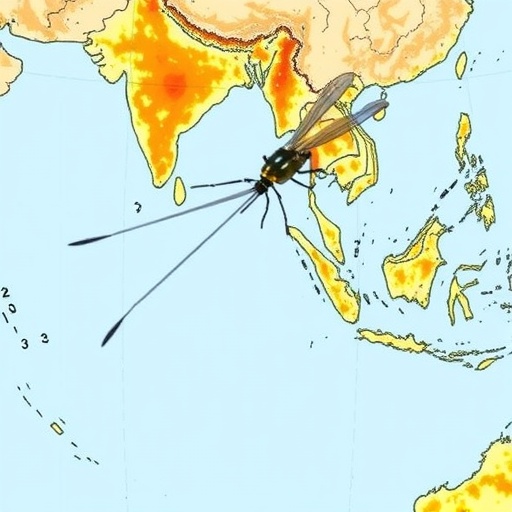In a groundbreaking study published in Nature Communications, researchers have unveiled a concerning link between the intensification of the El Niño–Southern Oscillation (ENSO) and the escalating risk of dengue fever outbreaks. The study meticulously dissects the climatological and epidemiological interplays that drive the global spread of dengue, highlighting how variations in ENSO amplitude influence regional weather patterns in ways that create optimal breeding conditions for Aedes mosquitoes—the primary vectors responsible for dengue virus transmission.
ENSO, a naturally occurring climate phenomenon characterized by fluctuations in ocean surface temperatures across the central and eastern Pacific, exerts profound influences on global weather systems. The two primary phases, El Niño and La Niña, alter temperature, rainfall, and humidity patterns in ways that ripple across continents. This study reveals that as ENSO amplitudes increase—a trend observed in recent decades through both natural variability and anthropogenic climate change—the frequency and intensity of dengue epidemics correspondingly rise. This discovery places ENSO dynamics at the forefront of infectious disease modeling and public health forecasting.
Dengue fever, a mosquito-borne viral illness affecting millions worldwide, has proven notoriously difficult to control due to the complex environmental and biological factors governing its spread. The research team employed a comprehensive model integrating ENSO indices, regional climate data, and dengue incidence reports over several decades. Their analysis demonstrated robust predictive capability, linking stronger ENSO events with anomalous warm and wet conditions in dengue-endemic regions. These climatic anomalies foster accelerated vector breeding cycles and increased biting rates, thereby escalating transmission potential.
Intercontinental teleconnections—atmospheric wave patterns that propagate ENSO impacts to distant regions—emerged as critical elements in this dynamic. The study highlights that ENSO’s reach extends far beyond the Pacific basin, modulating monsoon systems, altering precipitation regimes, and inducing temperature shifts across tropical and subtropical zones. Such climate perturbations create transient but favorable niches enabling the sustainable proliferation of Aedes mosquitoes beyond their traditional habitats, hinting at an expanding geographical footprint for dengue risk zones.
Notably, the research underscores how the amplitude, rather than frequency, of ENSO episodes exerts a stronger influence on dengue risk. Larger ENSO swings amplify climatic anomalies, intensifying the environmental conditions conducive to vector population booms. This insight challenges earlier assumptions that focused on the mere occurrence of El Niño or La Niña events, urging a reevaluation of how ENSO metrics are employed in epidemiological models and public health preparedness frameworks.
The implications of these findings extend well beyond academic intrigue. As climate change is projected to increase ENSO intensity and volatility, regions previously unexposed to severe dengue outbreaks could face emergent health crises. Urban areas in South America, Southeast Asia, and parts of Africa may see shorter inter-epidemic intervals and more explosive transmission phases. The study calls for a recalibration of vector control strategies, emphasizing the integration of climate forecasting tools to anticipate and mitigate dengue surges in vulnerable communities.
Researchers also pinpoint a crucial temporal lag between ENSO-induced climate anomalies and dengue outbreak peaks. This lag period—ranging from several weeks to months—presents a critical intervention window. By harnessing ENSO predictive models coupled with real-time vector surveillance, public health officials can implement proactive vector control measures, community education campaigns, and healthcare resource allocation to blunt the impact of impending outbreaks.
Additionally, the study addresses the synergistic effects of urbanization and climate-driven ENSO variations. Rapid population growth and inadequate infrastructure in tropical cities exacerbate mosquito breeding conditions, compounding the risk associated with ENSO-driven climatic fluctuations. The interplay of poor water management, increasing temperatures, and altered precipitation patterns forms a perfect storm for dengue transmission, particularly in densely populated urban centers.
One of the most compelling aspects of the research is its integration of a multidisciplinary approach, combining climatology, epidemiology, entomology, and computational modeling. This synthesis enables a nuanced understanding of how macro-scale climate oscillations cascade into micro-scale ecological and societal impacts. Through the deployment of machine learning algorithms on extensive datasets, the research team achieved unprecedented precision in forecasting dengue incidence linked to climate variability.
The geographic scope of the study is impressively comprehensive, encompassing diverse dengue-endemic regions across Latin America, Southeast Asia, and the Western Pacific. This global perspective elucidates how regional climatic responses to ENSO events differ due to varying atmospheric circulation patterns, topography, and socio-economic factors, tailoring dengue risk predictions with regional specificity.
Furthermore, the investigation sheds light on the adaptation strategies of Aedes mosquitoes to fluctuating environmental conditions. Increased ENSO amplitude not only affects breeding site availability but also influences mosquito survivorship, viral replication rates within vectors, and feeding behavior—all factors that govern the intrinsic transmissibility of dengue virus in affected populations. Such vectorial capacity adjustments heighten the potential for more severe and widespread epidemics.
Policy implications of this research are profound. Governments and international health organizations are urged to incorporate ENSO amplitude metrics into existing dengue surveillance and response frameworks. Early warning systems that integrate climate data could revolutionize epidemic preparedness by enabling timely mobilization of vector control resources, vaccinations where applicable, and public sensitization efforts to reduce human-mosquito contact.
The study’s authors advocate for expanded climate-health interdisciplinary collaborations to refine predictive models further and to develop region-specific intervention strategies. Emphasizing the dynamic nature of ENSO and its teleconnections underscores the urgent need for flexible, climate-informed health policies capable of responding to rapidly evolving dengue threats.
In conclusion, this pivotal research spotlights the rising dengue risk shadowed by increasing ENSO amplitude, painting a stark picture of a world where climate variability intensifies infectious disease burdens. It propels the conversation beyond traditional disease control paradigms, merging climate science with public health to confront the mounting challenge of vector-borne diseases in a warming, more variable climate system.
Subject of Research: The study explores the relationship between El Niño–Southern Oscillation amplitude variations and the increased risk of dengue fever outbreaks globally.
Article Title: Rising dengue risk with increasing El Niño–Southern Oscillation amplitude and teleconnections.
Article References:
Tian, Y., Xu, Y., Liang, Y. et al. Rising dengue risk with increasing El Niño–Southern Oscillation amplitude and teleconnections. Nat Commun 16, 8629 (2025). https://doi.org/10.1038/s41467-025-63655-0
Image Credits: AI Generated
Tags: Aedes mosquito breeding conditionsanthropogenic climate influencesclimate change and dengue correlationDengue fever outbreaksEl Niño Southern Oscillation impactsENSO amplitude effectsepidemiological studies on dengueglobal dengue risk assessmentinfectious disease modelingmosquito-borne illness trendspublic health forecasting for dengueweather patterns and disease spread





